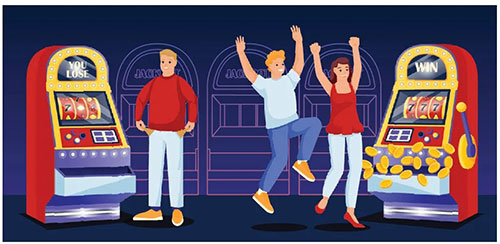LOOSE OR TIGHT?
Finding the loosest slots in the new era of low payback
By Frank Legato

As you may know, this is the month our sister publication, Strictly Slots, announces the annual “Loosest Slots Awards.” These awards acknowledge the casinos or casino regions that recorded the highest payback percentages on slots for the entire previous year.
The report combines data from the 12 individual monthly public reports to identify the casinos where players can expect the highest returns on their slot dollars. The casinos covered in this report have always been required by their jurisdictions to report monthly “hold” statistics publicly —showing the percentage of all wagers the casino won from all slot players. Casino Player reports the other side of that equation, showing how much of all players’ wagers are returned as winnings on the slot machines.
This annual report is particularly important these days, as slot payback, known in the trade as “return to player,” or RTP, has remained stagnant with numbers that are significantly lower than they once were. Between the 2008 recession, the 2014 contraction of the Atlantic City casino market and, finally, the Covid-19 crisis and subsequent shutdowns, slot directors have been hesitant to return RTP levels to where they were in the mid-2000s.
Adding fuel to the fire have been academic studies that purport to show players don’t know the difference between high and low payback percentages. The most recent such study essentially plunked players in front of the same exact game in consecutive sessions—a low RTP, say 88 percent, for one session and a different program, say 94 percent RTP, in the second. They were unable to identify which was which.
I wrote in this space at the time that the methodology was flawed, because the sample size was way too small. A slot machine, regardless of the payback percentage, must by law have any result, including the top jackpot, available on any spin. The programs of tighter slots have numbers representing low wins and losing spins overwhelming the total pool of possible results, but that will only be obvious to a player in the long run. In the short run, anything can happen, including a hot streak on an 88 percent game or a dreadful session on a 94 percent game.
As our readers have told us in countless letters, they notice the real effect of the lower overall payback numbers—they simply don’t win as much on the slot floor as they once did. It’s not an issue for some players, judging from the massive and sustained popularity of games in the penny denomination, which, on average, return 89 percent or less. There are plenty of players happy to accept a house advantage of 12 percent because they’re content to hold and spin, fill pots and piggy banks, and speed through free-spin bonuses all night, even if they do mostly lose in the end.
But there are still plenty of other players who want a more fair deal in their slot experience—a reward for consistent, repeat play in the form of a lower house edge, which is to say, a better chance of walking away a winner.
That’s why the annual Loosest Slots Awards are important. They show that there are still casinos that offer higher returns on the slot floor. The winner for the Loosest Slots in the U.S. for the third year running, remarkably, isn’t even a casino. It’s an off-track betting parlor adjacent to the Resorts World New York City racetrack casino in Queens that includes a 1,000-game slot floor. In 2023, Nassau OTB at Resorts World New York City returned an astonishing 97.36 percent of slot wagers to players as wins.
No one else in the survey was even close. Good for the locals in Queens. It was good for locals outside of New York as well—namely, in Nevada, which, according to the report, is home to the second-through fifth-loosest slots in the nation. Atop that market is Reno, a repeat winner in this category, which returned 94.57 percent. Reno’s a great place to play, and not just because it sits next to the Sierra Nevada mountains and Lake Tahoe. Many casinos there cater to the locals, with consistently high payback percentages.
While I do enjoy staying at older places like the Eldorado and the Grand Sierra (I remember when it was the MGM), for high returns not only on slots but, notably, on video poker, no one beats the Atlantis. And it’s got a killer spa.
Right behind Reno in the Nevada market is the group of casinos designated by the state as “Balance of County,” defined as Clark County casinos off the Las Vegas Strip, excluding the area known as the Boulder Strip. This includes casinos like the Palms, the Orleans, the Rio and the South Point. (The latter, my personal favorite casino, is technically on Las Vegas Boulevard, but miles south of the cluster of mega-resorts identified as the Strip.) This group returned 93.66 percent of wagers to players.
Mesquite was third in Nevada at 93.66 percent, but no other casino or casino region in the nation touched 93 percent in overall payback. Atlantic City, my home market, managed only 91.46 percent in payback—by Harrah’s. That’s with one decent-paying video poker game. (I know where it is. It’s a real treasure hunt looking for good video poker these days in the East.)
In any event, the bottom line for those who care about slot returns in general still comes down to one mantra: Play where the locals play.
Or go to Queens.


